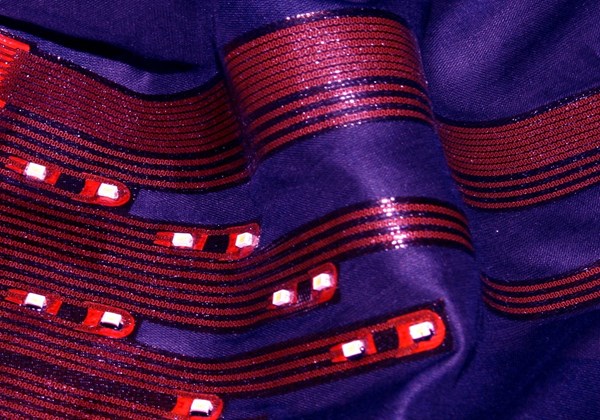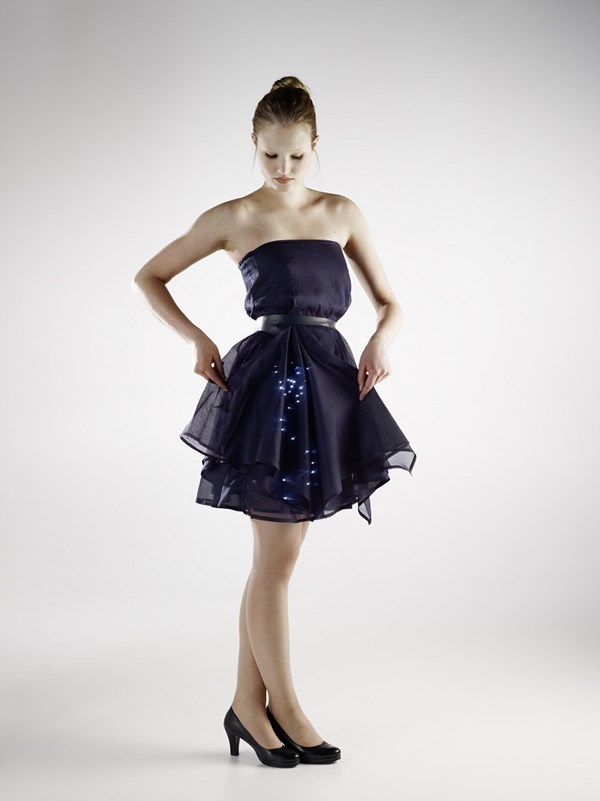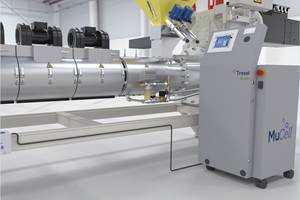Smart Electronics for Luminous, Smart, Sustainable Clothing
Covestro will βshineβ at K 2016 showcasing an item of luminous clothing with a TPU formable film/copper laminate as key.

Covestro will “shine” at K 2016 showcasing an item of luminous clothing with a TPU formable film/copper laminate as key.
Our September pre-K 2016 issue includes a feature on materials and additives and you will notice that there is no shortage of new developments in those arenas. Expect to see some pretty exciting new applications showcased by most key suppliers.
One example, is Covestro, Pittsburgh, Penn., which will showcase an item of luminous clothing that utilizes light-emitting diodes (LEDs) to make it stand out, but also can also perform key functions such as protecting pedestrians and cyclists against accidents. What makes it unusual is that the LEDs are not positioned on a panel or strip, but on a piece of soft fabric.
Central to this development is an electronic system that is responsive to movements without losing its functionality. This system comprises a flexible and formable film made from a Covestro TPU. It serves as the substrate for the printed copper circuits which are arranges in a meandering pattern and can thus also be bent and stretched.
This “intelligent” technology involves the manufacture of smart circuits using the following efficient, multi-stage process:
• First, copper films are laminated onto the TPU films.
• The printed circuits are produced in a subsequent structuring operation, which reportedly features highly-effective adhesion.
• The coated films are then shaped as required using conventional thermoforming.
According to Covestro film expert Wolfgang Stenbeck, the TPU films are resistant to standard etching and imaging processes. “Formable electronic systems can be directly laminated onto textiles, as is the case of the luminous dress,” he said.
This production technology is part of various projects funded by the EU Commission, among them STELLA and TERASEL. The objective is to product 2.4-dimensional electronic circuits cost-effectively using conventional forming processes. The freely-formed components can be integrated seamlessly into energy-efficient electronic components. They can be processed using standard PCB industry equipment and are also suitable for applications with higher currents or voltages. Compared to conventional electronic components, the smart circuits offer greater design freedom and reliability while enabling more sustainable products for a variety of industries due to the reduced use of materials. Here are some exciting applications this technology offers:
• There’s a wide range of options for smart textiles, alone. In addition to fashion items, freely-formable electronic systems are already in use in underwear, where they monitor heart rate and breathing. They assist patients with therapy and help athletes monitor their training.
• TERASEL technology also enables production of modular automotive interior components in which all functions are already integrated. It boasts reduced complexity in assembly, lower costs and shorter time to market. It is also said to clear the way for new lighting concepts in automotive interiors and buildings, where designers and architects can position LEDs exactly where they are most needed.
• In consumer electronics, smart circuits are supporting the trend toward increased miniaturization of components, as they can be incorporated directly into the outer shell of products.
• Stretchable circuit board (SCB) technology for manufacturing electronic circuits was developed earlier as part of the STELLA project. This was led by the Fraunhofer Institute for reliability and Microintegration (IZM) and the Technical University of Berlin. Coated TPU films can be stretched repeatedly up to 60%, and on a one-time basis by as much as 300%.

Related Content
NPE2024 Wrap-Up: Sustainability Dominates Show Floor News
Across all process types, sustainability was a big theme at NPE2024. But there was plenty to see in automation and artificial intelligence as well.
Read MoreThe Importance of Mass Balance in Chemical Recycling
Approaches to mass balance can dramatically impact calculations of recycled content.
Read MoreMultilayer Solutions to Challenges in Blow Molding with PCR
For extrusion blow molders, challenges of price and availability of postconsumer recycled resins can be addressed with a variety of multilayer technologies, which also offer solutions to issues with color, processability, mechanical properties and chemical migration in PCR materials.
Read MoreFoam-Core Multilayer Blow Molding: How It’s Done
Learn here how to take advantage of new lightweighting and recycle utilization opportunities in consumer packaging, thanks to a collaboration of leaders in microcellular foaming and multilayer head design.
Read MoreRead Next
For PLASTICS' CEO Seaholm, NPE to Shine Light on Sustainability Successes
With advocacy, communication and sustainability as three main pillars, Seaholm leads a trade association to NPE that ‘is more active today than we have ever been.’
Read MoreSee Recyclers Close the Loop on Trade Show Production Scrap at NPE2024
A collaboration between show organizer PLASTICS, recycler CPR and size reduction experts WEIMA and Conair recovered and recycled all production scrap at NPE2024.
Read More











